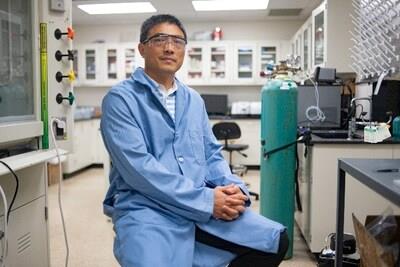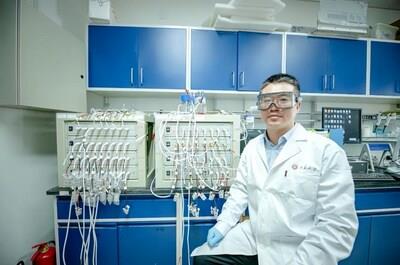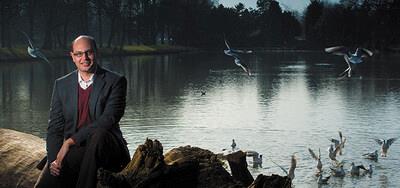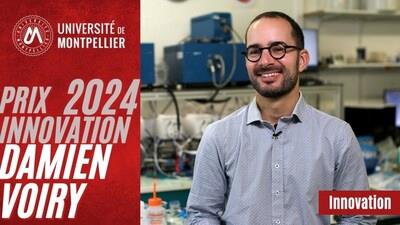(MENAFN- PR Newswire)
BEIJING, Dec. 16, 2024 /PRNewswire/ -- A report from China Science Daily.
What picture forms in your mind when imagining top youth scientists?
Continue Reading

Yu Guihua: A Sharp and Resolute "Hunter"

Guo Shaojun: An Ambitious and Resilient "Miner"

Simon Gozling: A Bold Cross-Disciplinarian and Enthusiastic "Diplomat"

Damien Voiry: A Steady and Perfectionist "Gardener"
If you have to describe their personalities through a professional lens, which occupation would come to mind?
Are they hunters , adept at identifying and chasing objectives with confidence and daring?
Or miners , dedicated to digging into their fields of interest, tackling obstacles with perseverance and calm?
Perhaps they are diplomats , enjoying interactions and excelling in collaboration with enthusiasm and glamour?
Or could they be gardeners , driven by introspection and a quest for perfection, meticulously cultivating the fruits of science with an artist's touch?
At the recent 2024 Young Scientist SDGs Award Ceremony, we discovered these personas embodied by the four awardees. The China Science Daily conducted exclusive interviews with these global awardees to explore how these distinct personas have guided their unique yet interconnected paths in science.
Yu Guihua: A Sharp and Resolute "Hunter"
Yu Guihua, Professor of the University of Texas at Austin, has built an impressive resume, marking him as a scientist of consistent achievement. Prior to receiving the 2024 Young Scientist SDGs Award, Yu Guihua had already earned more than 80 international accolades for his groundbreaking research and teaching achievements.
Yu Guihua's team specializes in the precise design and green synthesis of new-type functional nanomaterials, notably the frontlines of research on energy and eco-friendly gel materials. Their innovation achievement, the solar hydrogel technology, provides a sustainable and efficient method for producing clean water, significantly lessening the dependence on specific geographic and hydrological conditions for agriculture development.
"I grew up in a mountainous region where water was scarce. My grandparents often walked 20-30 minutes to collect water from a stream. This childhood instilled in me a deep appreciation for the value of clean water," Yu Guihua shared in the interview.
In middle school, Yu Guihua developed a keen interest in chemistry. He excelled academically, securing admission to the University of Science and Technology of China in 1998, where he majored in physical chemistry. After earning his bachelor's degree in 2003, he went on to pursue further studies at Harvard University, completing his Ph.D. in materials chemistry in 2009. Yu Guihua then spent three years as a postdoctoral researcher under Professors Bao Zhenan and Cui Yi at Stanford University. In 2012, he joined the University of Texas at Austin, where he is now serving as an assistant professor of Materials Science and Engineering as well as Mechanical Engineering.
Interdisciplinary research spanning physics, chemistry, materials science, and mechanical engineering has shaped Yu Guihua's distinctive academic approach. "These experiences subtly cultivated my deep thinking, frequent communication, and broad collaboration," Yu Guihua remarked. He encouraged youth researchers to venture beyond their comfort zones and explore knowledge and methods from diverse disciplines and fields.
"Staying within your comfort zone makes it difficult to discover your true potential," Yu Guihua emphasized, drawing inspiration from his colleague John B. Goodenough, the oldest Nobel laureate to date. Goodenough received the Nobel Prize in Chemistry at 97 for co-inventing lithium-ion batteries. Yu Guihua often recalls Goodenough's advice to the youth: "To achieve greater success, you must break out of your comfort zone and possess the drive and perseverance to overcome challenges."
In recent years, Yu Guihua's team has achieved several groundbreaking advancements in multifunctional gel materials. "When uncertainty looms, it's crucial to slow down and think deeply. Youth scientists should define a clear focus in their research, recognize their core strengths, and apply these strengths to solving significant sci-tech challenges," Yu Guihua told the China Science Daily.
Yu Guihua believes that expanding interdisciplinary knowledge and adopting a multidisciplinary mindset can provide youth scientists with broader perspectives and deeper insights. "My wife's experience in economic development, food security, and sustainable agriculture in developing countries has enriched my understanding of sustainability from sociological and economic viewpoints."
Regarding the bonus, Yu Guihua and his wife have already made plans. "We intend to donate the bonus to charitable organizations to support the application of sustainable technologies that enhance the quality of life for the vulnerable, offering affordable solutions for clean water access, health and sanitation improvements, and increased agricultural productivity and water use efficiency," he stated.
Guo Shaojun: An Ambitious and Resilient "Miner"
Guo Shaojun embodies the rare "engineer's" demeanor – understated, quiet, and meticulous. To his colleagues and students, he is the quintessential pragmatist.
This character likely stems from his rigorous research background. After earning his bachelor's degree in materials chemistry from Jilin University in 2005, Guo Shaojun pursued a master's degree in analytical chemistry at the Changchun Institute of Applied Chemistry, Chinese Academy of Sciences. Following his doctoral graduation, he conducted postdoctoral research at Brown University in the U.S. In 2013, he joined Los Alamos National Laboratory as an Oppenheimer Distinguished Fellow. Guo Shaojun returned to China and join Peking University in 2015, where he is now a Boya Distinguished Professor and a Full Professor with Tenure in the School of Materials Science and Engineering.
The five years Guo Shaojun spent at the Changchun Institute of Applied Chemistry, Chinese Academy of Sciences, were transformative. Under the guidance of Professor Wang Erkang, a renowned analytical chemist in China and member of the Chinese Academy of Sciences, Guo Shaojun was profoundly influenced by the "artisan" spirit of older-generation scientists, who dedicated their lives to mastering their craft. This experience instilled in him a resilient and indomitable character, driving him to tackle challenges head-on.
Guo Shaojun specializes in the research of key materials and devices for fuel cells, hydrogen energy, and secondary batteries. His significant contributions have earned him a place on the list of Highly Cited Researchers globally for 11 consecutive years from 2014 to 2024. He has also received numerous prestigious awards and honors, including the First Prize of Natural Science Award by the Ministry of Education (as the lead researcher), the first Scientific Exploration Award, the China Youth Science and Technology Award, the Mao Yisheng Science and Technology Award for Beijing Youth, the Chinese Chemical Society - Royal Society of Chemistry Young Chemists Award, the National Science Fund for Distinguished Young Scholars, the Beijing Science Foundation for Distinguished Young Scholar, and the Chief Scientist of the National Key Research and Development Program.
"Productive" and "resilient" are the accurate descriptions for Guo Shaojun's team. In terms of academic outcomes, they are a prolific group, with over 200 publications in highly-influential journals including Nature and Science. In terms of technology capacity, they are renowned for tackling tough challenges, achieving multiple breakthroughs in core technologies for fuel cells and green hydrogen production through water electrolysis. Notably, the catalysts and membrane electrode assemblies developed by the team have reached leading international standards.
"To make significant contributions in this field, one must excel in basic research, applied research, and technology transfer," Guo Shaojun said. This is why he chose Peking University. "Peking University provides a robust environment for both fundamental and interdisciplinary research, making it an ideal platform for cross-disciplinary researchers."
Over the past nine years, with support from Peking University, Guo Shaojun has led his team to the forefront of science and key technology development in the field of hydrogen catalysis. "Our goal for the next five years is to scale up these cutting-edge technologies for practical applications," he stated with determination.
Simon Gozling: A Bold Cross-Disciplinarian and Enthusiastic "Diplomat"
A meeting with Simon Gozling leaves a lasting impression, particularly due to his exceptional communication skills. At the 2024 Young Scientist SDGs Award Ceremony, he delivered a fluent and engaging speech without notes, earning applause from the audience. "I'm not a typical lab scientist. My network spans various fields, including politicians, business leaders, and even artists," Simon Gozling told the China Science Daily.
Simon Gozling enjoys communication and expression. Climate science, a field that benefits greatly from effective storytelling, aligns well with his strengths. The projects he leads often have a strong interdisciplinary focus. He excels at translating rigorous scientific evidence into actionable policy recommendations, bridging the gap between global policymakers and scientists from diverse disciplines.
At the 2015 United Nations conference where the Paris Agreement on climate change was signed, Simon Gozling provided crucial scientific evidence to negotiators regarding the socio-economic and environmental benefits of setting global warming limits. He played a key role in supporting the EU's climate adaptation strategy and carbon neutrality policies. Recognized for his interdisciplinary dedication and climate change policy advocacy, Simon Gozling has been named one of the world's 1,000 most influential climate scientists and has received the Lloyd's Science of Risk Prize in the Climate Change category.
"One of the biggest challenges in climate change research is its interdisciplinary nature. Addressing these issues requires collaboration with experts from various fields, including physics, chemistry, environmental science, and ecosystem studies. It is also crucial to consult economists to understand the economic impacts of climate change, as climate change is one of the most serious challenges the world faces today, impacting the future of all humanity," Simon Gozling explained.
In his collaborations with experts from different disciplines, Gozling has observed that each field has its own technical language, which can hinder effective integration. One of his key goals is to facilitate more international, interdisciplinary, and cross-sector projects to better and more quickly address climate change issues.
When asked about his plans for the bonus of RMB1 million, Simon Gozling laughed and said, "I plan to use this funding to enhance the skills I use in my work." Science communication is a significant part of his daily responsibilities. How to better convey scientific ideas, data, and research findings to key decision-makers in climate change is a frequent concern for Simon Gozling. In some cases, he even collaborates deeply with designers, artists, and musicians to learn skills related to science communication.
The honor and the bonus of RMB1 million from the 2024 Young Scientist SDGs Award will surely enable more possibilities for collaboration and exchange for this "diplomat" scientist, enhancing global climate governance and action.
Damien Voiry: A Steady and Perfectionist "Gardener"
If described using the popular MBTI assessment, Damien Voiry is of typical "i" personality, indicating quiet and introverted nature.
Damien Voiry serves as a professor at the University of Montpellier in France, dedicating his career to integrating fundamental scientific research with practical applications. His team focuses on scaling up CO2 electrolysis for key chemical production, designing advanced two-dimensional material membranes for water purification, and exploring CO2 recycling. A primary research direction is the sustainable conversion of captured carbon into useful chemicals for industry.
Damien Voiry's team has made several groundbreaking achievements in recent years. By exploring the relationship between oxidation state stoichiometry, grain boundary density, and catalytic efficiency in metal catalysts, they have significantly improved CO2 conversion. In water purification, they have designed nanolaminated membranes using the unique properties of two-dimensional materials, achieving excellent permeability and selectivity for energy-efficient clean water solutions. These achievements have earned Damien Voiry accolades such as the Innovation Award from the un diversity of Montpellier, the 2022 Young Chemist Award from the French Chemical Society, and the 2021 IAAM Scientist Medal. The 2024 Young Scientist SDGs Award marks his first international recognition.
Reflecting on his academic career, Damien Voiry identifies the first two years at the University of Montpellier as the most challenging. With limited funding but the need to establish his laboratory, he applied for numerous grants to support his team. Fortunately, a significant grant from the European Union made a turning point: "That marked the beginning of my independent career."
Damien Voiry sees himself as a scientist of "gardener" type, being a perfectionist who strives for excellence in every research outcome. "Sometimes, my pursuit of perfection even delays publishing papers," Voiry laughed. He emphasized that his motivation lies in understanding the scientific mechanisms, and he finds great satisfaction when all experiments and data converge on the same conclusion, bringing him closer to the truth.
"A good study must be both useful and meaningful," Damien Voiry summarized his criteria for evaluating research.
Currently, this French scientist is leading his team in three main areas: the electrochemical conversion of CO2 to produce ethylene and carbon monoxide, the electrolysis of water to produce hydrogen, and the development of new membranes for water purification. Their ultimate goal is to create materials that are free of rare elements and easy to manufacture, aiming to provide practical solutions for sustainable development goals.
While each awardee has a distinct personality and fitting "persona," deeper conversations reveal that they embody a combination of all four personas:
In their research, they are goal-oriented and highly effective; in tackling complex challenges, they are persistent and undaunted; in interdisciplinary collaborations, they are open-minded and innovative; and in their commitment to science, they are ambitious and forward-thinking. Perhaps the charisma of top youth scientists extends even further. Regardless of their individual traits and paths, their ultimate goal remains the same: to uncover truths that benefit all mankind.
Do you aspire to be a top youth scientist? What is your ideal persona?
SOURCE China Science Daily
WANT YOUR COMPANY'S NEWS FEATURED ON PRNEWSWIRE?
440k+
Newsrooms &
Influencers
9k+
Digital Media
Outlets
270k+
Journalists
Opted In
GET STARTED
MENAFN16122024003732001241ID1108996168